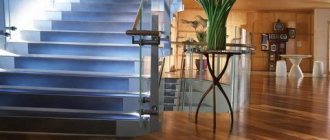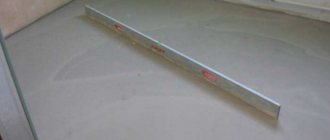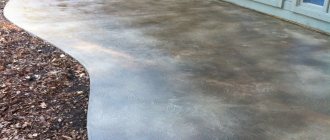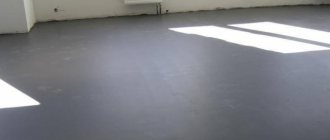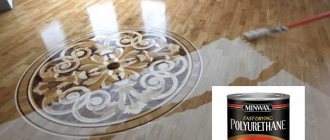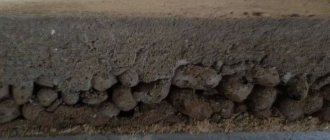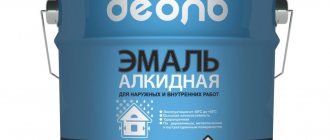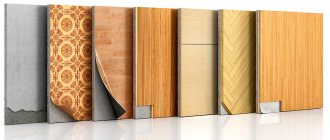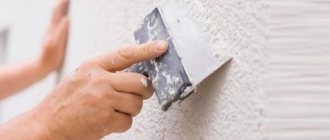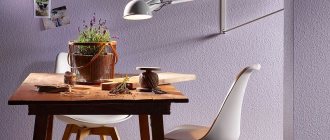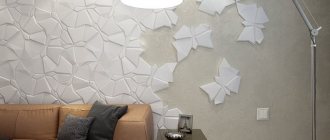Send a request Call a specialist
Rarely does anyone pay attention to the floor. It's smooth and that's the main thing. Most often, tiles of soft colors with an unobtrusive pattern are used for floors. But the future belongs to epoxy self-leveling floors. These bright coatings immediately attract attention, you can look at them for a long time, and most importantly, the surface of the floors is very smooth, despite the catchy, seemingly voluminous pattern. Initially, epoxy flooring was only available in industrial premises such as shopping centers, shops, and hotels. But since the technology for creating such a coating is improving every year, self-leveling floors have become available even in the smallest apartments. And manufacturers produce special mixtures that will help you create a bright and smooth surface yourself, without turning to specialists.
What is epoxy self-leveling floor
The main component of the self-leveling coating is a transparent epoxy resin for filling the floor, to which special hardeners, plasticizers and solvents are mixed. Also, various colorful bright decorative particles of various shades and other components can be added to these mixtures, designed to improve the quality of the self-leveling epoxy floor.
In addition, glitter and so-called chips are added to the mixture for self-leveling flooring. Glitters are shiny and iridescent particles similar to mother-of-pearl. Chips are reflective particles presented in the form of fibers. Depending on what decorative particles are added to the mixture for epoxy floors, there are 4 types of finished coatings:
- matte;
- glossy;
- semi-matte;
- semi-gloss.
Product varieties
What is the best way to make bathhouse floors with your own hands?
Depending on the specifics of the room’s operation, four types of resins are used: epoxy, polyurethane, mixed epoxy-urethane and methyl methacrylate. Each of them has its own advantages and some weaknesses.
Epoxy self-leveling floor. Ideal for finishing interior spaces with high traffic - halls of medical institutions, exhibition halls, schools, fitness centers. Able to maintain its original appearance and hygienic properties for a long time.
You need to buy epoxy self-leveling floors for installation in kitchens, medical and chemical laboratories.
Positive properties:
- Very hard, abrasion resistant;
- Tolerates high humidity well;
- Able to withstand low indoor temperatures;
- Epoxy resin for self-leveling floors is indifferent to the effects of most aggressive chemicals.
Features of operation:
- Requires an appropriate foundation with a compressive strength of 300 kg per m²;
- Fragility - can crack when hit by a heavy object or vibration.
Self-leveling polyurethane floors are suitable for indoor spaces where the temperature is relatively stable and there is a moderate amount of sunlight. They look good in residential areas and are often used in production.
Pros:
- Self-leveling polyurethane coating is capable of maintaining all properties under temperature changes from -30º to +50º;
- Elastic, not afraid of vibration, intense mechanical load;
- Withstands direct impacts;
- Can be installed on low to medium strength substrates;
- Resistant to high humidity, does not absorb water;
- Affordable price of polyurethane self-leveling floors.
Restrictions on use:
- Constant exposure to UV rays contributes to fading and reduced service life;
- More susceptible to chemicals.
Combined epoxy-urethane floor. Combines high strength with sufficient elasticity, resists moisture and chemicals, withstands vibration, UV rays, and mechanical stress.
Methyl methacrylate self-leveling floors:
- Easy to apply, pouring is possible at temperatures below +8º;
- Time from application to operation - 2 hours;
- They require good ventilation before the polymerization process is completed, due to the smell;
- Less resistant to both high loads and chemicals.
The last two types of coatings are not yet very common; epoxy and polyurethane self-leveling floors are more often used.
Types of self-leveling coatings
Epoxy resin floors are divided into two main types:
- Thin layer self-leveling epoxy floor. This coating is distinguished by the fact that the thickness of its filling is less than 1 mm. Characteristics: excellent moisture resistance, the floor can withstand the effects of aggressive chemical cleaners containing abrasive substances. Unfortunately, such floors cannot have a beautiful appearance.
- The second type of epoxy resin coatings includes floors with a pour thickness of more than 1 mm. In addition to all the advantages inherent in thin-layer floors, these coatings are also resistant to acids and alkalis, they are ultra-strong and durable, and also have an attractive and bright appearance.
In addition to these two main groups, there are three more types of self-leveling coatings:
- Epoxy industrial floors. Filling no more than 6 mm, they are able to withstand enormous loads, very heavy furniture and many people constantly moving on such a coating.
- Quartz-filled self-leveling floors. The thickness of pouring such a floor covering is from 1 mm to 6 mm. Thanks to the content of quartz sand, floors become highly resistant to mechanical stress, as well as to the action of chemical detergents containing abrasive particles. In addition, the floor is resistant to temperature changes.
- Self-leveling epoxy floor with increased transparency. The thickness of the filling layer of such a coating is 2 mm. But to create a beautiful decorative layer, you can fill it with a height of up to 5 mm. After complete drying, the epoxy resin for flooring forms a thin transparent film with increased light resistance; the coating is completely antistatic. This mixture is mainly used for filling photographs, 3D drawings and floor patterns.
Preparing the base
First, the worker must treat the base so that it becomes suitable for creating subsequent layers on top of it. It is worth noting in advance that in the case of leveling with a concrete screed, you can work at a temperature of at least 5 degrees Celsius and air humidity within 75-80 percent.
The preparation is carried out as follows:
- any defects on the subfloor are identified. If they are minimal, then they can be eliminated using ordinary cement-sand mortar or putty. The second option is more practical, since the cement mixture takes longer to dry;
- on large areas, it is recommended to work with a grinding and polishing machine, and then remove all dust, debris and other contaminants from the surface;
- the treated surface is primed to increase the adhesion of the applied epoxy composition, and quartz sand is poured over the applied primer layer.
In what rooms can epoxy flooring be poured?
Flooring in the form of epoxy flooring can be used both in industrial premises and in apartments and private houses in the country.
Interesting to know! The self-leveling coating is always cool to the touch, so before installing it in residential areas, you should install electric floor heating.
Such a floor should be abandoned if water pipes will pass under it. If one of them bursts, you will have to open the entire coating, and this is a labor-intensive and very expensive task. As a result, you will have to re-fill the floors. Because epoxy flooring is non-slip, it is very convenient in shopping malls. And modern panoramic 3D drawings will add unusualness and attractiveness to the room.
Environmental friendliness
Many people refuse epoxy floors, believing that they are not environmentally friendly and even harmful. But in reality this is not the case. Polymers may contain the following substances:
- Epichlorohydrin.
- Anhydride.
- Toluene.
- Hexamethyldiamine.
- Polyethylpolyamine.
It is these substances in high concentrations that are harmful to human health. But they only stand out when filled
, completely leaving the coating during the polymerization process. That is, after 3-5 days there will be no trace of them left in the room! That is why epoxy floors are considered absolutely safe and environmentally friendly - this is confirmed by numerous studies and certificates.
Note:
It is necessary to apply polymers while wearing protective equipment. Be sure to use a respirator, gloves and goggles.
Epoxy floors are absolutely environmentally friendly - they are used in laboratories and hospitals
Advantages and disadvantages
Like any building material, epoxy resin flooring has its pros and cons. Thanks to them, you can decide whether it is worth installing such a coating. The advantages include:
- coating strength;
- no seams;
- resistance to chemicals;
- fire safety – epoxy flooring is not subject to fire;
- ease of maintenance of the coating;
- wear resistance - the floor can be used for at least 20 years;
- absolutely harmless to people and pets;
- Huge selection of colors and designs.
The advantages of such a floor also include the fact that epoxy coating for concrete floors does not release any harmful substances into the environment. But there are also disadvantages to epoxy flooring. The disadvantages include:
- high price;
- difficulty in installing the coating; It is quite difficult to make an epoxy resin floor with your own hands;
- it is almost impossible to remove.
The disadvantages, of course, are noticeably fewer, but they are there. If it is necessary to remove the epoxy floor, then this action is impossible, but you can simply pour a new layer of the mixture onto the old surface, then the coating will be renewed.
Step-by-step installation instructions
How to do
filling
yourself
? It's not difficult if you follow the instructions.
Tools and materials
The first step is the purchase and preparation of tools and materials:
two-component epoxy coating of a suitable grade;
- rollers on long rods, long-haired;
- needle shafts;
- paint shoes and respirator;
- plastic mixing container without corners;
- wide rule and spatulas;
- construction mixer (drill with a special attachment);
- deep penetration primer (concrete contact type);
- construction vacuum cleaner or broom.
If the concrete base is old, with many defects, its restoration will require:
- putty;
- Grinder.
Preparation
At this stage, you can act alone. If the concrete slab is new, it will be enough to remove dust and cover it with two layers of primer. If there is damage - cracks, areas that are crumbling, potholes and chips - it is necessary to carry out restoration. The recesses are covered with putty.
Areas where the concrete crumbles are hollowed out to solid material and filled with a cement mixture or a special repair compound. After filling the defects, it is necessary to sand and go over the entire surface with a vacuum cleaner or broom. Using rollers with a long question, the dust-free coating is treated with a primer.
How to install epoxy flooring yourself
To make a high-quality epoxy floor with your own hands, you must adhere to a certain order of work stages:
- Preparing the base for pouring.
- Creating the main floor layer.
- Making a decorative layer.
- Final floor covering.
Pouring the floor begins with preparing the base
The most important thing is that the base must be completely horizontal. If there is even a slight slope, there will be an overconsumption of expensive material. Therefore, during the preparation of the base for the self-leveling floor, it is leveled with special concrete screeds. In the process of preparing the base for pouring, the old coating is completely cleared, then the debris is carefully swept out and vacuumed so that not a speck remains.
Important! One of the mandatory conditions is that the humidity of the base for the epoxy floor in the apartment should not exceed 4%.
When preparing the base for the floor covering, priming is carried out. A special mixture of epoxy primer for concrete floors is mixed with a construction mixer until smooth. In order for all air bubbles to disappear from the surface of the finished solution, you need to wait 5-7 minutes. Since the ready-made soil solution is useful for only 40 minutes, you need to mix it in precisely the proportions that will allow you to keep it within this short period of time. The primer is poured onto the prepared base using a snake. Using a regular padding polyester roller, the solution is carefully distributed, achieving a glossy floor. It is possible that some areas will absorb too much primer. Then you should add more solution exactly to these places and distribute it with a roller again. Polymerization occurs within 24 hours. When the primer has hardened, you can eliminate visible defects and pour a second layer, which will also dry for a day.
Creating the main floor layer.
When creating a base layer, all primer defects are completely hidden. Therefore, the layer thickness can be approximately 1.5 mm. The primer layer is again poured onto the prepared floor. Then it is carefully distributed using a spatula. After 20-30 minutes, special quartz sand is poured onto the entire floor surface. After this, you need to leave the floor to dry for 20 hours. Then the remaining sand is swept away with a plastic brush of increased rigidity and vacuumed.
Making a decorative layer.
This layer is an epoxy floor coating; it is installed on a ready-made primed base. The mixture is diluted according to the instructions using a mixer and after 5 minutes you can distribute it on the floor. Level the floor using a spatula. Decorative elements are added at this stage. After the layer is laid, you need to wait another 20 hours for drying.
Final coating.
The final stage requires very careful execution. You need to be extremely careful to avoid defects that will ruin the floor covering. The finished mixture is also diluted using a mixer; it is ready to use in 5 minutes. Then it is poured into wide strips, leveling the surface with a squeegee. After this, you need to go over it with a ring roller, which removes air bubbles, leaving a perfectly smooth and even surface. The final layer hardens within a day, but you should not use the room for about another week.
Interesting! In addition to the fact that the epoxy self-leveling floor has a smooth and glossy surface, it can be additionally varnished. This action will bring additional safety when using the floor. After varnishing the flooring with polyurethane varnish, you must wait 4-5 days and then you can use the room.
Tools for work
Before installing the floor, it is advisable to watch a video on pouring compounds or read information in magazines for construction and repair (“Do it yourself” and others). Next, it is important to prepare the following materials and tools:
- padding polyester roller for priming, needle roller for removing air bubbles;
- a squeegee for applying epoxy, a spatula for leveling and rubbing in hard-to-reach places;
- a drill with a paddle attachment - will help in mixing the resin and hardener;
- paint shoes - you can walk on the floor in them, they will not damage the coating.
Also, for cleaning instruments, a solvent is purchased, for personal protection - gloves, a respirator, and goggles. You also need to have a vacuum cleaner in order to promptly remove the remaining quartz sand if it is used at work.
User reviews
On the Internet you can find many articles and reviews dedicated to the newfangled floor covering. Reviews about epoxy self-leveling floors boil down to the main opinion - so far this type of coating is very expensive. Although it is expected to operate for at least 20 years, people are not ready for such large expenses. On average, when purchasing an epoxy self-leveling floor, you will notice that the price of materials per m2 ranges from 350 rubles. It's quite expensive. Many users praise the self-leveling epoxy floor coating Rizopox 4101. Those who have had such a floor in their home for several years are very satisfied and recommend it to everyone. As noted by such users, during the operation of the floor it did not undergo any changes, did not fade or lose color after using special detergents.
